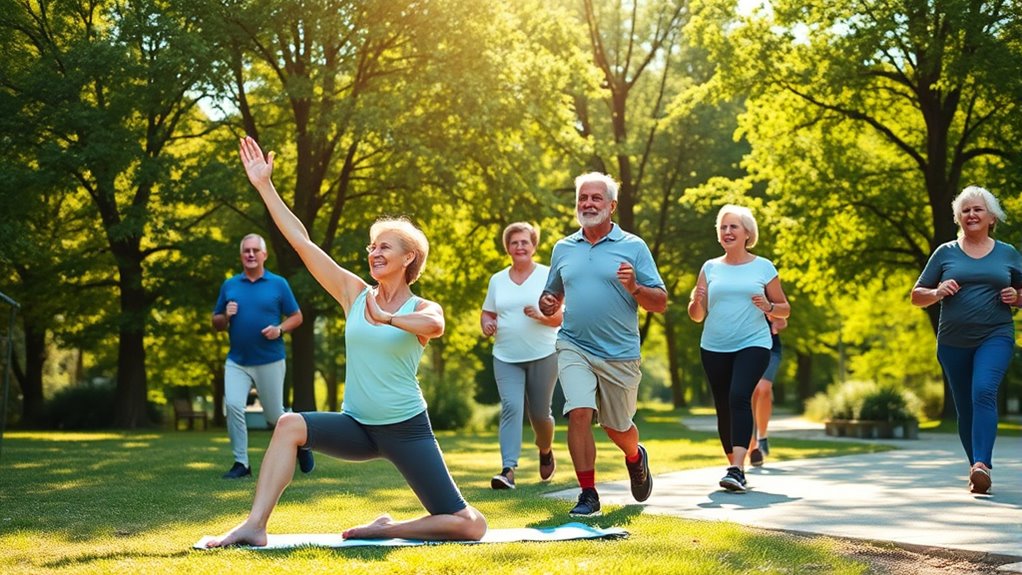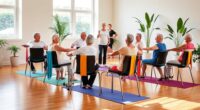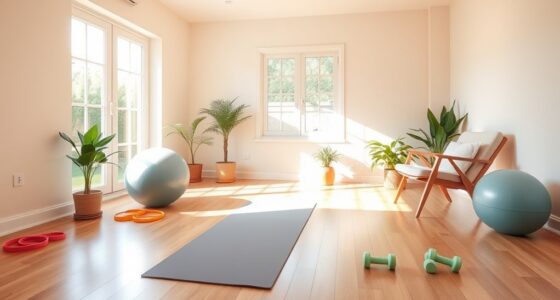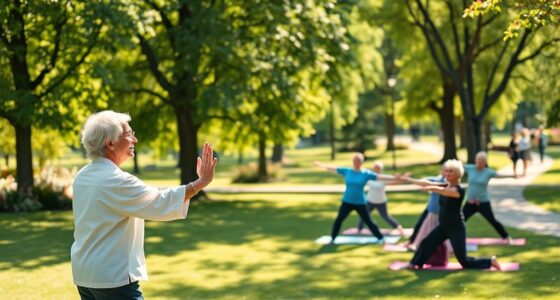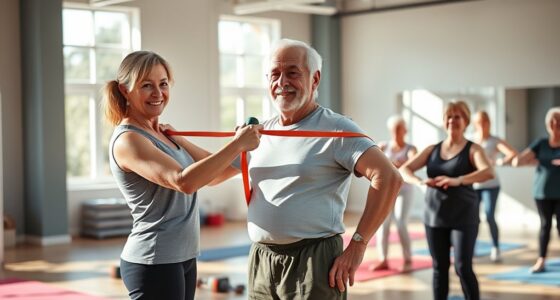Staying fit as a senior is all about regular physical activity. It boosts your heart health, lifts your mood, and sharpens your mind. You can try low-impact exercises like chair yoga, water aerobics, or even dancing to keep things fun. Remember to break workouts into shorter sessions and tap into community support for motivation. Safety is key, so consult your healthcare provider before starting anything new. Stick around to discover more tips for an active lifestyle!
Key Takeaways
- Engage in low-impact exercises like chair yoga, water aerobics, and cycling to enhance strength, balance, and cardiovascular health.
- Break workouts into short sessions to easily incorporate physical activity into daily routines.
- Participate in community-based exercise programs to build social connections and combat loneliness.
- Set realistic, achievable fitness goals tailored to your current health and capabilities, and track your progress.
- Prioritize safety by consulting healthcare providers, staying hydrated, and wearing proper footwear during exercise.
The Importance of Physical Activity for Seniors
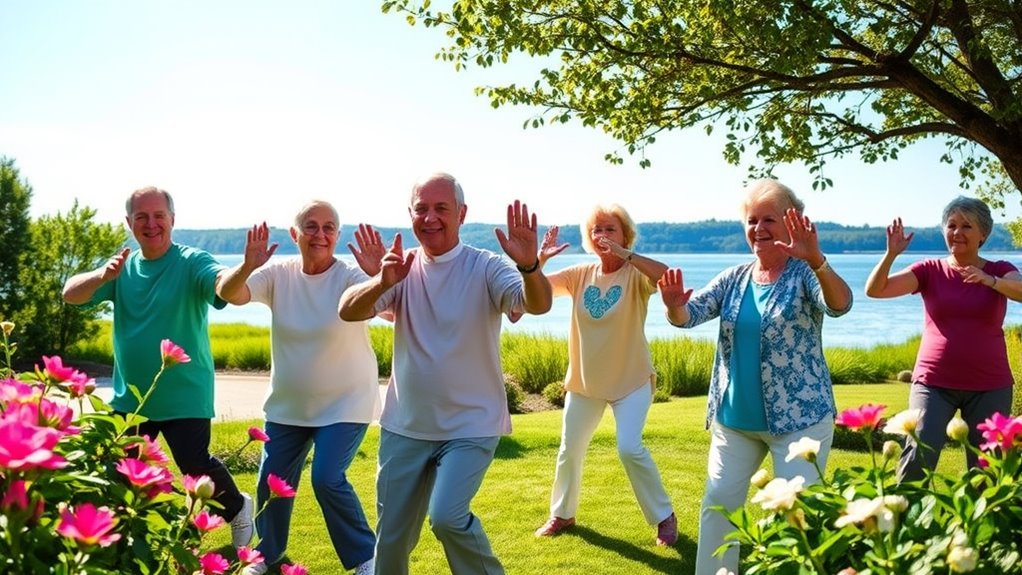
As you age, staying physically active becomes essential for maintaining your health and independence. Regular exercise greatly improves your cardiovascular health, reducing the risks of heart disease and stroke. It also enhances your mental well-being by lowering stress and symptoms of depression. Staying active supports cognitive function, which can help lower the risk of dementia and Alzheimer’s disease. Additionally, it increases your mobility and balance, minimizing the chances of falls and fractures. Engaging in physical activity fosters social connections, combating loneliness. For those managing chronic conditions, exercise can improve insulin sensitivity, lower hypertension risk, and strengthen bones. Ultimately, embracing a physically active lifestyle enriches your life, helping you maintain independence and enjoy everyday activities. Regular physical activity also reduces healthcare costs associated with chronic diseases, allowing you to invest in other aspects of your well-being. Furthermore, establishing a structured routine around exercise can enhance motivation and consistency in your fitness journey.
Types of Exercises Recommended for Seniors
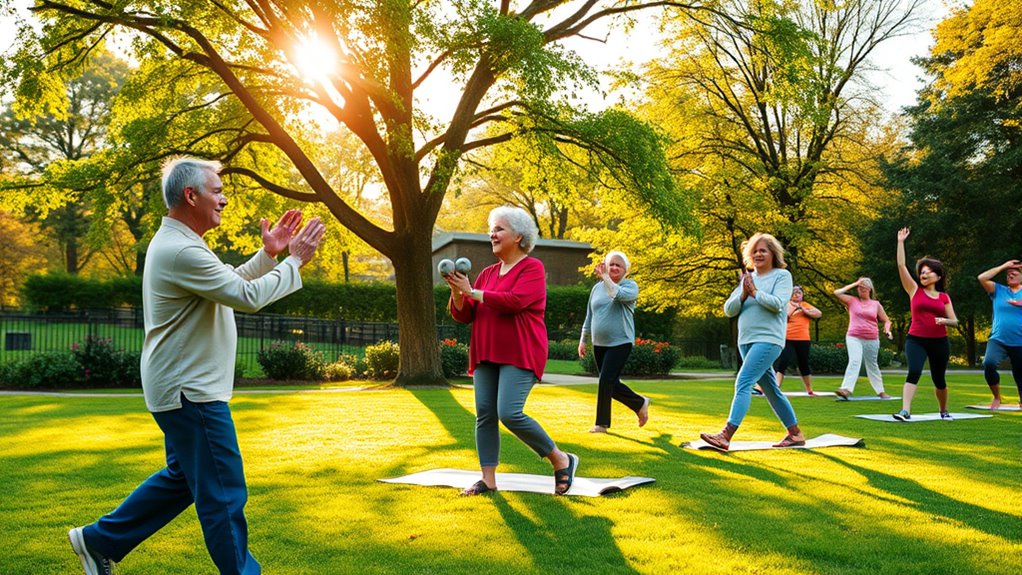
When considering exercises suitable for seniors, it’s crucial to focus on low-impact activities that promote strength, balance, and cardiovascular health. Chair yoga and tai chi enhance flexibility and balance, while cycling offers a great cardiovascular workout without stressing your joints. Engaging in regular exercise can significantly reduce the likelihood of falls, which is essential for maintaining safety in older adults. Using appropriate techniques can further enhance stability and mobility during these exercises. Additionally, practicing primitive skills can help improve coordination and enhance overall fitness. Incorporating MVP (Minimum Viable Product) approaches in exercise routines can help seniors test and adapt their fitness strategies effectively. Creating transformative spaces can also play a significant role in encouraging seniors to remain active and engaged in their exercise routines. Moreover, cultivating a mindful environment can enhance the overall experience of physical activity.
Water aerobics provides a full-body workout, perfect for seniors seeking low-impact options. For strength training, resistance bands and dumbbell exercises are effective and easy to incorporate. Simple movements like sit-to-stand and wall pushups can greatly improve mobility and strength. Don’t forget about walking, an accessible way to boost heart health.
Incorporating these exercises into your routine can help you stay fit while minimizing the risk of injury.
How Regular Exercise Benefits Overall Health
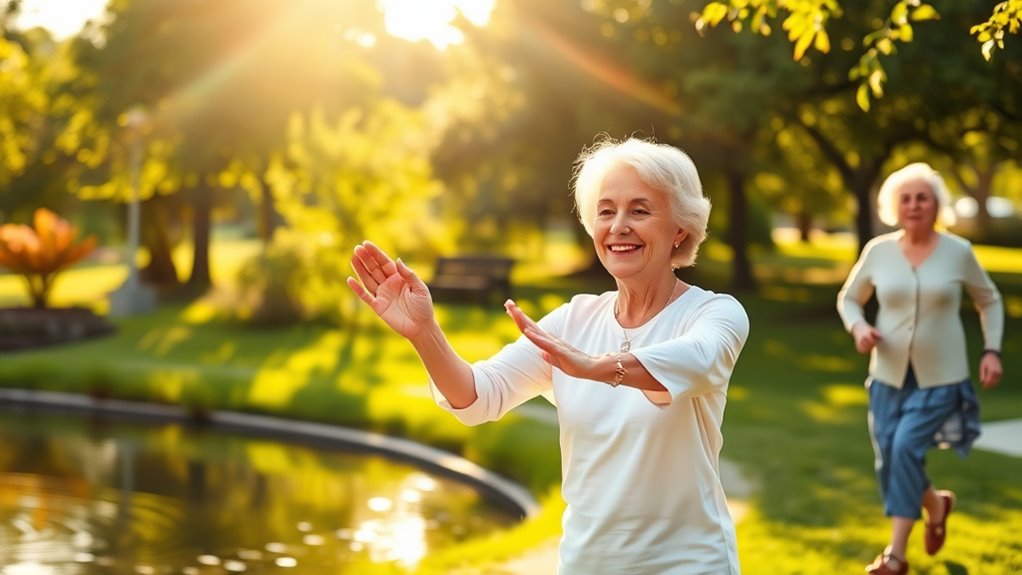
Regular exercise greatly enhances your overall health, offering numerous benefits that extend well beyond physical fitness. It helps prevent diseases like heart disease, stroke, diabetes, and certain cancers, while boosting your immune function. Exercise also reduces the risk of high blood pressure and cholesterol, and it can delay the onset of dementia, including Alzheimer’s. Additionally, regular physical activity can aid in maintaining a healthy weight, which is crucial for preventing chronic diseases. Engaging in regular exercise can significantly improve both physical and mental health, leading to a more fulfilling life. Furthermore, consistent exercise can also help mitigate common health concerns that many older adults face. Incorporating stress management techniques can further enhance the benefits of regular exercise and overall well-being.
Moreover, individuals with conditions like BPD may find that regular exercise serves as a vital tool for managing emotional regulation and improving overall well-being. Mentally, physical activity releases endorphins that relieve stress and improve mood, while enhancing cognitive function. You’ll enjoy better sleep quality and reduced symptoms of depression and anxiety. Additionally, regular exercise improves strength, flexibility, and balance, making daily tasks easier and reducing the risk of falls.
Overcoming Barriers to Exercise Participation
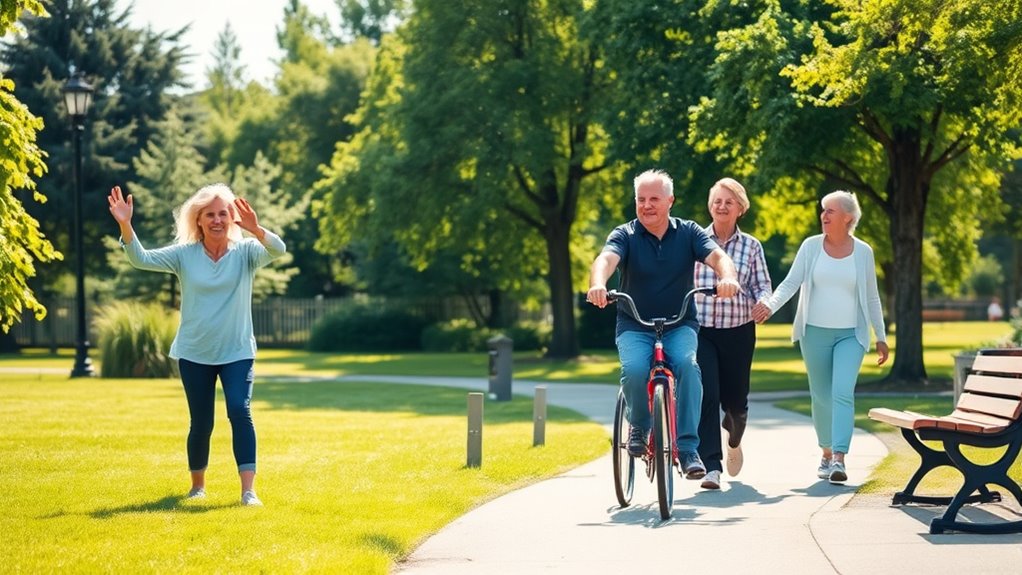
Although many seniors face barriers that can hinder their participation in exercise, it’s vital to recognize that overcoming these obstacles is possible with the right strategies.
Start by breaking your exercise into short sessions, making it easier to fit into your daily routine. Prioritize these sessions like important appointments to guarantee you stay on track. Incorporating functional exercises can help improve your overall strength and balance, enhancing your ability to perform daily activities. Engaging in community or group activities can also provide motivation and support from others on similar journeys. Additionally, adopting a regular routine of low-impact exercises can significantly reduce physical strain while promoting overall fitness. To enhance your exercise experience, focus on maintaining high vibrational energy to attract positive outcomes and enjoyment.
If physical limitations concern you, consult your healthcare provider for safe, low-impact options. Fear of injury can often be alleviated by starting slowly and choosing exercises that suit your abilities. Don’t forget to set achievable goals to keep your motivation high and consider exercising with a friend for added support.
Celebrate your progress, no matter how small, and focus on the health benefits of staying active. With these strategies, you can successfully overcome barriers and enjoy a healthier lifestyle.
The Role of Community in Senior Fitness

Community plays an essential role in enhancing fitness for seniors, as it provides both support and motivation for staying active. Engaging in community-based exercise programs can greatly improve your physical and mental health. Local organizations offer tailored activities that promote safety and confidence, making it easier for you to participate. Group exercise classes not only boost your physical fitness but also help you build friendships, reducing feelings of loneliness. Additionally, studies show that social connections can significantly improve overall well-being and longevity in seniors. Furthermore, participation in group activities can help mitigate feelings of isolation associated with cognitive decline, such as that seen in dementia and Parkinson’s disease. Plus, community events foster camaraderie, making fitness a more enjoyable experience. Accessible facilities cater to your needs, ensuring you can safely join in. Ultimately, being part of a fitness community enhances your sense of belonging and purpose, leading to a healthier, happier lifestyle. Additionally, structured exercise programs are designed to be enjoyable and relevant, further encouraging seniors to stay active and engaged in their fitness journey. Engaging in group activities can also promote collaboration and teamwork, enhancing motivation and enjoyment in fitness routines. Moreover, participating in dynamic communication exercises can also strengthen the bond between seniors, encouraging them to share their fitness experiences and support one another. This sense of community can be boosted by unplanned weather changes that lead to creative indoor activities, ensuring that fitness remains a fun part of your routine.
Tips for Starting Your Exercise Journey
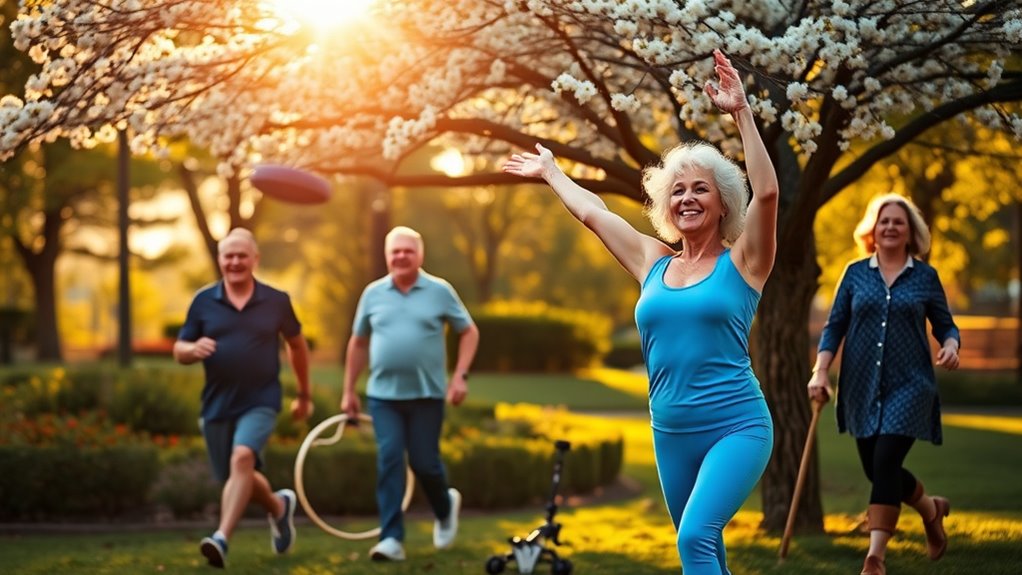
How can you kickstart your exercise journey effectively? Start by consulting your physician, especially if you have chronic health conditions.
Next, set realistic, specific goals that help you stay motivated. Choose enjoyable activities like walking or swimming to make exercising something you look forward to. Additionally, consider incorporating low-carb meal options into your diet to support your fitness goals. Engaging in regular exercise can also contribute to emotional and psychological growth, which is essential as we age. In addition, recognizing patterns of emotional coldness in relationships may encourage a more supportive environment for your fitness journey. Practicing yoga techniques can be a gentle way to enhance your flexibility and strength. It’s also important to remember that incorporating juice cleansing into your diet can help you detoxify while providing essential nutrients.
Begin with low-intensity exercises and gradually increase the frequency and duration to minimize injury risks. Incorporate technology, like fitness apps, to track your progress and boost motivation.
Aim for at least 150 minutes of moderate aerobic activity weekly, along with strength training and balance exercises. Engaging in regular exercise contributes to improved mental health and cognitive function as you age.
Finally, mix in flexibility routines to enhance your overall fitness. With these tips, you’ll build a sustainable and enjoyable exercise routine!
Safety Considerations for Exercising Seniors
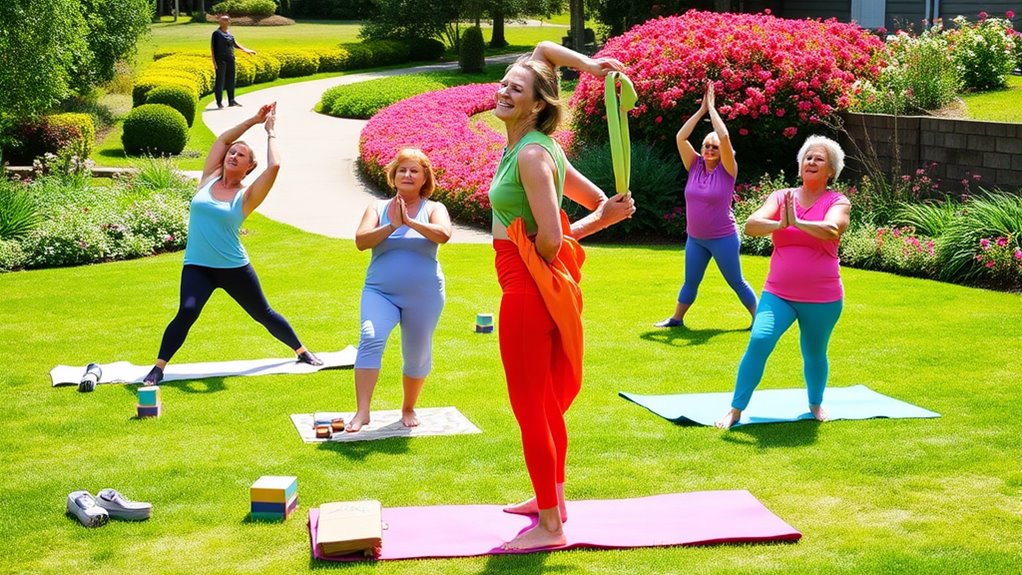
When it comes to exercising as a senior, prioritizing safety is essential to guarantee a positive experience and prevent injuries. Start by consulting your healthcare provider before beginning any new routine. Always warm up to prepare your muscles and improve balance, and choose a safe location free from tripping hazards. Stay hydrated to avoid dehydration, especially if you’re on certain medications. Wear proper footwear to reduce fall risks. Incorporate both dynamic and static stretches to enhance flexibility and reduce the risk of strain. It is also important to engage in regular veterinary check-ups to ensure that any underlying health issues are identified and managed appropriately. Additionally, ensure you are exercising in a space with good air quality, as this can enhance your overall well-being. Seniors texting humor can also help alleviate feelings of isolation, making exercise more enjoyable. Avoid extreme temperatures by exercising indoors when necessary, and make certain of good air quality. Incorporate balance and strength exercises to enhance coordination and maintain muscle mass. Listening to your body to prevent overuse injuries is crucial, and considering using support, like a chair, during balance activities for added safety is also recommended. Engaging in regular prenatal check-ups can help monitor any health concerns that may arise during exercise. Moreover, keeping an eye on routine health checks can help detect potential issues early on.
Setting Realistic Goals for Fitness Success
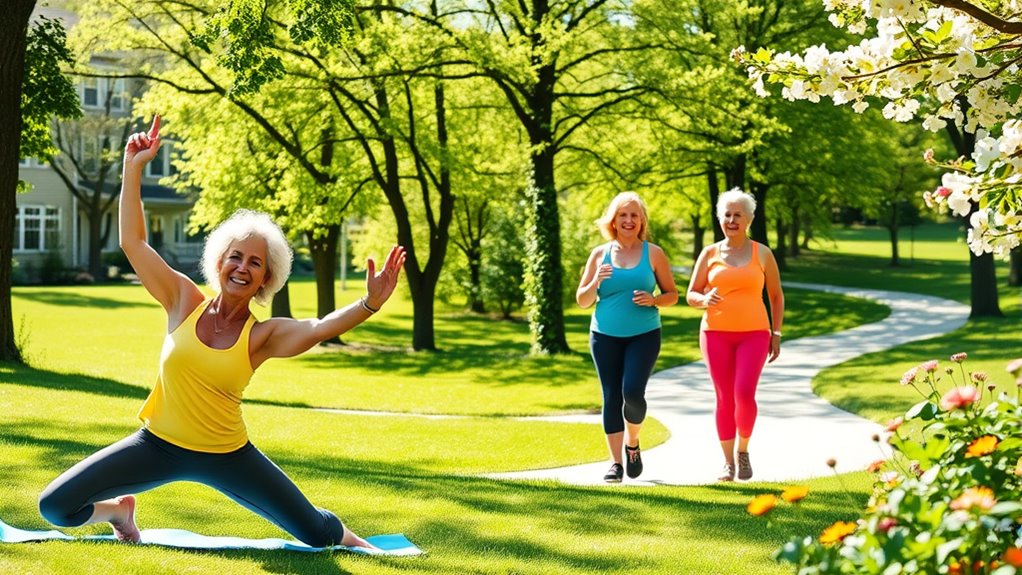
Setting realistic fitness goals is essential for seniors looking to enhance their health and well-being. Start by evaluating your current health and physical capabilities, making sure your goals are Specific, Measurable, Achievable, Relevant, and Time-bound (SMART). Awareness of common small mistakes in fitness routines can also help prevent setbacks.
Choose activities that match your fitness level, like walking for cardiovascular health or low-impact exercises to minimize joint strain. Begin with small, manageable targets and gradually increase their complexity. Assessing current health status will help you tailor your fitness program to meet your individual needs and limitations. Additionally, consider consulting with a healthcare professional about dementia medications that may affect your physical activity levels. Investing in diversification of your physical activities can lead to a more well-rounded fitness routine.
Keep track of your progress using diaries or apps to stay motivated. Incorporate a mix of strength, flexibility, and balance exercises, allowing ample time to reach each goal. Regularly reflecting on your achievements can enhance your motivation and commitment to your fitness journey.
Finally, consult with healthcare professionals to tailor your plan and make certain it stays realistic as your needs change.
The Value of Social Support in Staying Active
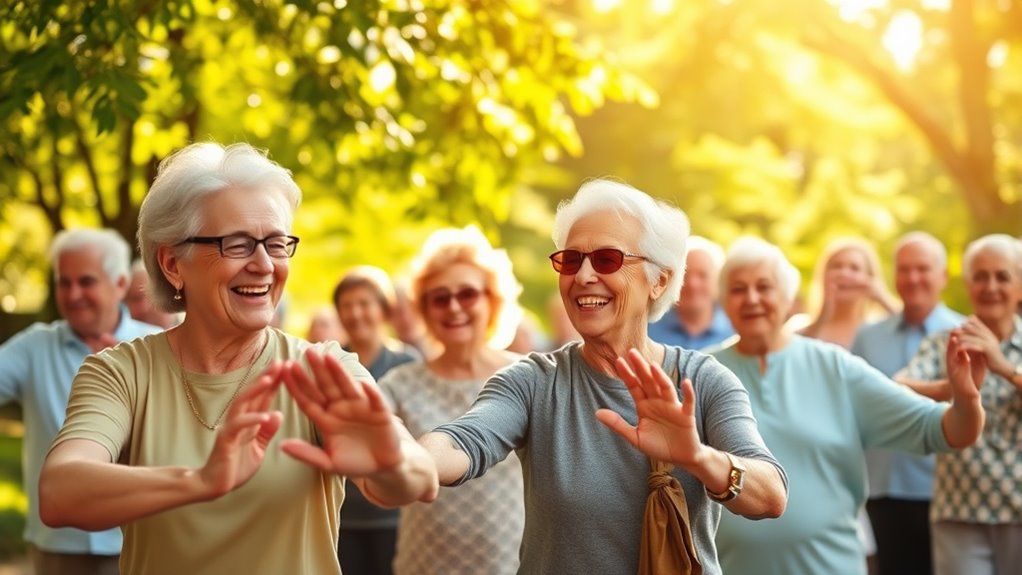
While staying active is essential for your health as a senior, the support you receive from friends and family can make all the difference. Social support boosts your motivation and engagement, encouraging you to stay active. In fact, overall social support has been significantly associated with higher levels of physical activity among older adults. When you exercise with others, you not only reduce feelings of loneliness but also expand your social network, enhancing your overall well-being. Group activities, like fitness classes, help you meet exercise guidelines more easily and create a sense of community.
Plus, the emotional benefits of social connections improve your mental health, making it easier to stick to your fitness routine. Ultimately, having a support system can lead to better health outcomes and a more fulfilling active lifestyle.
Enjoyable Activities to Keep You Motivated
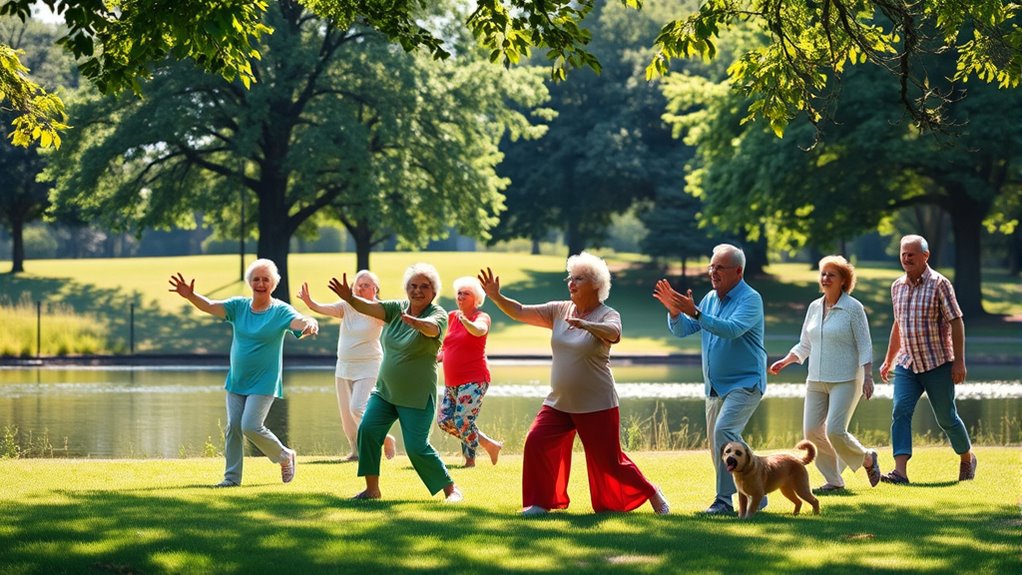
Finding enjoyable activities can greatly boost your motivation to stay active as a senior.
Discovering fun activities can significantly enhance your motivation to remain active in your senior years.
Consider chair yoga for flexibility, or immerse yourself in water aerobics for a gentle, full-body workout. If you love music, dancing can be a fun way to get moving. Gardening not only keeps you active but also lets you enjoy the outdoors.
Explore creative activities like balloon badminton for coordination or photography for a blend of walking and artistry. Outdoor activities encourage socialization and emotional well-being, making them an excellent choice for connecting with others.
Join a walking club for social interaction while improving cardiovascular health. Don’t forget about resistance bands for strength training or group fitness classes that combine fun and support.
Engaging in these enjoyable activities will keep you motivated and enhance your overall well-being.
Frequently Asked Questions
How Can I Stay Motivated to Exercise Regularly?
To stay motivated to exercise regularly, set specific, achievable goals that you can track.
Celebrate your successes, no matter how small, to reinforce positive behavior.
Engage with friends or join group classes for social support and accountability.
Mix up your activities to keep things fun and enjoyable.
Finally, recognize and address any barriers you face, and be flexible with your routine to maintain consistency without relying solely on motivation.
What Should I Wear for Exercising Safely?
Imagine slipping into a second skin, ready to conquer your workout.
To exercise safely, wear breathable fabrics like spandex or polyester that support your movements. Choose compression wear for added muscle support and moisture-wicking materials to keep you dry.
Opt for slip-resistant shoes to prevent falls, and consider adaptive designs if you need easier options.
How Do I Know if I’m Exercising at the Right Intensity?
To know if you’re exercising at the right intensity, pay attention to your heart rate and perceived exertion.
Aim for 50-70% of your maximum heart rate, which you can calculate by subtracting your age from 220.
Alternatively, use the Borg scale or a simplified 1-10 scale to gauge how hard you’re working.
If you can talk but not sing during the activity, you’re likely in the moderate intensity range.
Can I Exercise if I Have Chronic Health Conditions?
Yes, you can exercise even if you have chronic health conditions.
Start with gentle activities like walking or swimming, which are low-impact and easy on your body. It’s essential to listen to your body, so pay attention to any discomfort.
Gradually increase your activity level, and consider consulting your healthcare provider for personalized advice.
What Are Some Fun Ways to Incorporate Exercise Into Daily Life?
You can easily incorporate exercise into your daily life in fun ways!
Try walking while completing chores, like grocery shopping or walking your dog. Join a walking club for social motivation, or take a dancing class to enjoy movement with others.
Gardening is another great option that gets you moving outdoors.
Even simple activities like vacuuming or playing tennis can add a playful twist to staying active throughout your day!
Conclusion
Staying fit as a senior isn’t just about exercise; it’s about embracing a lifestyle that keeps you engaged and healthy. Take, for instance, Martha, a 70-year-old who joined a local walking group. She not only improved her stamina but also made new friends, turning fitness into a fun social activity. By prioritizing movement and community, you can enjoy a vibrant, active life that enhances your well-being. So get moving, connect with others, and reveal your full potential!
